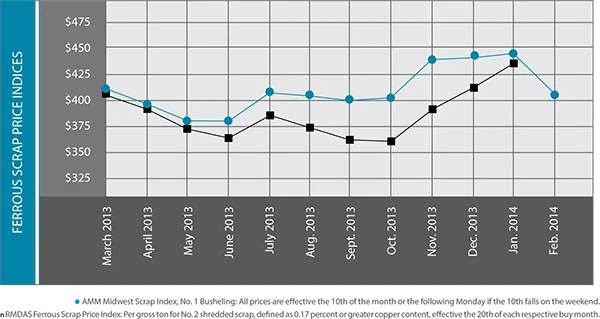
In the fourth quarter of 2013, several nonferrous scrap dealers said they felt a prolonged market recovery would take place in the first quarter of 2014. However, as of mid-February, many dealers are expressing pessimism regarding nonferrous scrap markets.
The housing sector continues to be a drag on nonferrous metals. Late last year, the sector appeared to be emerging from an extended, multiyear slump. More recent figures, however, show the housing sector is cooling off, and with it demand for nonferrous metals.
The extreme weather in parts of the U.S. during the first six weeks of 2014 also has affected the nonferrous scrap trade, slowing movement and generation.
Several sources say the sharp run-up in nonferrous scrap prices several years ago cleared out much of the obsolete scrap that was stored away. This has left little obsolete material to replenish supplies, one metal recycler says.
“Everyone is fighting over the same tons,” another scrap dealer says.
As scrap dealers bid against each other for available tons, their margins are becoming practically nonexistent.
Some analysts say the market is nearing bottom, however. In a recent report, the investment house JP Morgan released a report noting that copper scrap availability likely will improve by the second quarter of 2014 because of wider discounts to copper cathode.
For copper scrap dealers, China remains an area of great concern. The country is the largest consumer of copper scrap, accounting for close to half of the world’s copper consumption.
While China’s economy continues to grow, signs point to economic headwinds. A downturn in the Chinese economy will have a major impact on material price and flow, whether it is copper cathode or scrap.
Copper scrap dealers have been closely watching China’s buying pattern after consumers took two weeks off for Chinese New Year. As of mid-February, it appears China has become slightly more aggressive with its copper buying as its inventories have declined.
Despite a rally toward the middle of February, a number of dealers say it is a ‘dead cat’ bounce with little economic support behind it.
Copper prices have slipped by more than 15 percent over the past 12 months and haven’t reached bottom yet. According to one report, production of refined copper will top demand by 385,000 metric tons in 2014.
Aluminum markets remain challenging and overcapacity continues to overwhelm demand.
While aluminum producers throughout North America and Europe cut capacity, China continues to expand its capacity, leaving a huge oversupply of aluminum on the market, sources say.
Domestically, demand for aluminum scrap has improved. According to the U.S. Geological Survey (USGS), the domestic aluminum industry purchased an estimated 825 million pounds of aluminum scrap during October 2013, a 7.6 percent increase from October 2012.
Additionally, the USGS estimates that the recovery of aluminum and aluminum alloys totaled 719 million pounds, an increase of 11.4 percent year over year. During the first 10 months of 2013, preliminary data indicate that recovery of aluminum from scrap totaled an estimated 6.5 million pounds, up 2.8 percent over 2012.
However, while domestic demand has been good, aluminum scrap exports have been soft at 3.4 billion pounds for the first 10 months of 2013, down more than 10 percent from the prior year.
The LME has begun the process of changing its warehousing program, which it says created a “false” inventory problem for nonferrous metals. The LME has been the subject of significant criticism in light of the problem and has introduced steps that it says should reduce the buildup of supplies at its warehouses. The changes are expected to be implemented by April 1, 2014, but the LME says it already is seeing wait time for metals stored at its warehouses decline.
Although aluminum markets look cloudy in the short term, positive signs are further down the road. The trading house Sumitomo, according to Bloomberg, is forecasting a global aluminum deficit in 2015 as the massive cuts taking place will finally achieve the goal of strengthening aluminum prices.
A manager of light metals trading at Sumitomo tells Bloomberg he expects global aluminum demand to outpace supply by 37,000 metric tons in 2015 compared with a surplus of 312,000 tons expected in 2014.
Nickel markets could show life as preliminary figures show stainless steel production will strengthen through 2014.
The consulting group MEPS International, based in the U.K., says total annual global crude stainless steel production in 2013 reached an all-time high of an estimated 37.3 million metric tons. This surpasses the previous record, set in 2012, by 5.5 percent. MEPS forecasts that worldwide output will increase by a further 4.6 percent in 2014 to a new peak figure of 39 million metric tons.
MEPS says it expects global stainless steel output to climb by 6.8 percent in 2014, reaching 19.3 million metric tons in 2014.
In the U.S., MEPS says it expects production to continue to display moderate growth of 1.2 percent in 2014, pushing annual output to 2.05 million metric tons.
Get curated news on YOUR industry.
Enter your email to receive our newsletters.

Explore the March 2014 Issue
Check out more from this issue and find your next story to read.
Latest from Recycling Today
- Toppoint Holdings expands chassis fleet
- Lego creates miniature tire recycling market
- Lux Research webinar examines chemical recycling timetables
- Plastics producer tracks pulse of wire recycling market
- Republic Services, Blue Polymers open Indianapolis recycling complex
- Altilium produces EV battery cells using recycled materials
- Brightmark enters subsidiaries of Indiana recycling facility into Chapter 11
- Freepoint Eco-Systems receives $50M loan for plastics recycling facility







